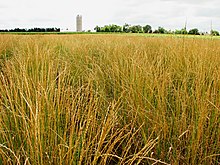| Thinopyrum intermedium | |
|---|---|

| |
| Scientific classification | |
| Kingdom: | Plantae |
| Clade: | Tracheophytes |
| Clade: | Angiosperms |
| Clade: | Monocots |
| Clade: | Commelinids |
| Order: | Poales |
| Family: | Poaceae |
| Subfamily: | Pooideae |
| Genus: | Thinopyrum |
| Species: | T. intermedium
|
| Binomial name | |
| Thinopyrum intermedium (Host) Barkworth & D.R. Dewey
| |
Thinopyrum intermedium, known commonly as intermediate wheatgrass,[1] is a sod-forming perennial grass in the Triticeae tribe of Pooideae native to Europe and Western Asia.[2] It is part of a group of plants commonly called wheatgrasses because of the similarity of their seed heads or ears to common wheat. However, wheatgrasses generally are perennial, while wheat is an annual. It has gained the Royal Horticultural Society's Award of Garden Merit as an ornamental.[3]
Trials with intermediate wheatgrass, the product of which is trademarked by the Land Institute as "Kernza", show that it can be grown as a "multi-functional" crop, yielding various commodities as well as ecosystem services. Whereas annuals such as corn tend to deplete soil organic matter and require inputs, a perennial grain such as intermediate wheatgrass can yield crops while building soil organic matter.[4][5]
- ^ USDA, NRCS (n.d.). "Thinopyrum intermedium". The PLANTS Database (plants.usda.gov). Greensboro, North Carolina: National Plant Data Team. Retrieved 9 December 2015.
- ^ The Grass Manual: Thinopyrum intermedium (intermediate wheatgrass) accessed 2013-01-31
- ^ "AGM Plants March 2020 © RHS – ORNAMENTAL" (PDF). rhs.org.uk. The Royal Horticultural Society. March 2020. Retrieved 11 September 2020.
- ^ Intermediate Wheatgrass. Green Lands Blue Waters. Retrieved: 2013-10-26.
- ^ Trademark information. Kernza Archived 2014-12-31 at the Wayback Machine. LegalForce. Retrieved: 2013-10-26.